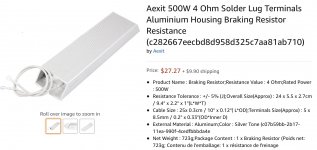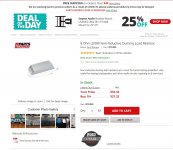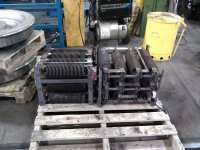I just came across these “brake resistors”, available in 4, 8 Ohms (and many other values). Power 500 Watt or 1000 Watt. Available mostly on Amazon, Ebay, Ali...
For audio I need at least a 150 Watt dummy. Currently I’m using big metal wirewound resistors with a heatsink and a lot of cooling. I’m thinking of putting them in a can filled with oil for better cooling, like I did with large RF dummy loads from Heathkit. I still remember the smell of boiling oil .
.
I wonder if anyone has ever tried these brake resistors as dummy load. I guess they will need extra cooling too?
Regards, Gerrit
For audio I need at least a 150 Watt dummy. Currently I’m using big metal wirewound resistors with a heatsink and a lot of cooling. I’m thinking of putting them in a can filled with oil for better cooling, like I did with large RF dummy loads from Heathkit. I still remember the smell of boiling oil
I wonder if anyone has ever tried these brake resistors as dummy load. I guess they will need extra cooling too?
Regards, Gerrit
Attachments
Those are intended for a one time dump, not continuous power.
If immersed in oil they could take more, but you'd have to test them to see.
Standard noninductive wirewound resistors work fine for audio loads.
No heat sinks needed, just use their mounting brackets to stand them off a surface
that can take high temperatures.
Res 270 | Ohmite Mfg Co
If immersed in oil they could take more, but you'd have to test them to see.
Standard noninductive wirewound resistors work fine for audio loads.
No heat sinks needed, just use their mounting brackets to stand them off a surface
that can take high temperatures.
Res 270 | Ohmite Mfg Co
Last edited:
Those dummy load resistors. "Brake resistor" is probably a translation issue.
Braking resistors are a thing - they're used to help slow down a large electric motor and dissipate the voltages they generate when a load is removed and they spin down.
Those dummy load resistors. "Brake resistor" is probably a translation issue.
No, brake resistors are standard components in high power motor controllers. If you can't dump energy you can't stop a motor under control.
The resistors at post #1 and #3 look more like a precharge resistor; typical application is to reduce the initial load current of the capacitor bank installed in a large motor control unit (a brushless motor, for example). It can also be used as braking resistor for small industrial motors. I have no direct experience with low cost no-brand import resistors of this type. A good quality resistor of this type built in EU costs about 5 times more. They are supplied with extensive specifications for proper sizing. At the rated power value, the increase in temperature above ambient temperature is typically 200 Kelvin; the resistor value will increase sharply at higher temperatures to maximize the chance of surviving a overload. Divide the rated power by 5 to keep the temperature rise below 50 Kelvin. In braking applications, the rated power of the braking resistor is often specified with a duty cycle of 5%. Divide the value by 20 to obtain maximum continuous dissipation. Obviously this a rough extimate; the manufacturer's datasheet will list the exact values.
Maybe someone will use these ones from the dynamic braking of a T1 subway car
They should be good for a few kW
Attachments
Last edited:
We've used these with water cooled aluminum blocks for high power dumping
and pulse testing of 200kW power converters.
Disk & Washer Resistors - HVP
and pulse testing of 200kW power converters.
Disk & Washer Resistors - HVP
Last edited:
They should be good for a few kWFrom what I gathered in person, those spirals are basically
the same as the coils on an electric stove... I'll bet they will glow under hard braking...
Those Ohmite edgewound resistors are very good, and are sometimes available as surplus.
We've used them in multiples in load banks for high power loads, with a bank of cooling fans.
Res Hclb | Ohmite Mfg Co
Res Wlrd6g | Ohmite Mfg Co
Last edited:
What did you use them for? Seem like a power intensive project?
What a cool concept. I wish they scaled down to like M3 hardware as cathode resistors
We've used these with water cooled aluminum blocks for high power dumping
and pulse testing of 200kW power converters.
Disk & Washer Resistors - HVP
What a cool concept. I wish they scaled down to like M3 hardware as cathode resistors
These work well for me. I bought a whole bunch and bolted them to a heat sink. I put a banana plug between each resistor so I can use jumpers and get anything between .5 and 32 ohms. Cheap too.
100W Watt Shell Power Aluminum Housed Case Wirewound Resistor New 1 to 5000 Ohm | eBay
100W Watt Shell Power Aluminum Housed Case Wirewound Resistor New 1 to 5000 Ohm | eBay
What did you use them for? Seem like a power intensive project? What a cool concept.
I wish they scaled down to like M3 hardware as cathode resistors
Those were for load testing a 200kW pulsed power converter. They are made of solid bulk ceramic,
and ours were 10R each, 6" in diameter, 1.5" thick, and we ran two in parallel to make a 5R load.
The aluminum block liquid cooling plates we made to sandwich each disc are also the electrical contacts
for connecting (big) wires. They certainly are very low inductance. Ohmite does have more bulk ceramic
material resistors in other package styles.
Bulk Ceramic Non-Inductive Resistors - HVP
Last edited:
Wow.
And to think I bought this: Un-blocked
Because this: Un-blocked
Exploded with the inrush...
EDIT: not sure why our forum says "Blocked"... the links work.
And to think I bought this: Un-blocked
Because this: Un-blocked
Exploded with the inrush...
EDIT: not sure why our forum says "Blocked"... the links work.
Maybe someone will use these ones from the dynamic braking of a T1 subway car
They should be good for a few kWFrom what I gathered in person, those spirals are basically the same as the coils on an electric stove... I'll bet they will glow under hard braking...
Now that's a dummy load
Exploded with the inrush.
They say "Pulse Withstanding Thick Film" but don't say what kind of pulse, guess it isn't all that big.
- Status
- This old topic is closed. If you want to reopen this topic, contact a moderator using the "Report Post" button.
- Home
- Amplifiers
- Tubes / Valves
- Brake resistor as dummy load?


